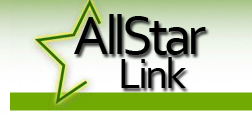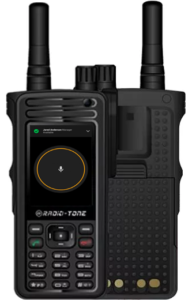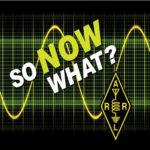One of the responsibilities of the Technical Coordinator in the Ohio Section is to submit something for the Section Journal. The Section Journal covers Amateur Radio related things happening in and around the ARRL Ohio Section. It is published by the Section Manager Scott – N8SY and articles are submitted by cabinet members.
Once my article is published in the Journal, I will also make it available on my site with a link to the published edition.
You can receive the Journal and other Ohio Section news by joining the mailing list Scott has setup. You do not need to be a member of the ARRL, Ohio Section, or even a ham to join the mailing list. Please sign up!
If you are an ARRL member and reside in the Ohio Section, update your mailing preferences to receive Ohio Section news in your inbox. Those residing outside the section will need to use the mailing list link above.
Updating your ARRL profile will deliver news from the section where you reside (if the leadership chooses to use this method).
Go to www.arrl.org and logon.
Click Edit your Profile.
You will be taken to the Edit Your Profile page. On the first tab Edit Info, verify your Email address is correct.
Click the Edit Email Subscriptions tab.
Check the News and information from your Division Director and Section Manager box.
Click Save.
Now without further ado…
Read the full edition at:
THE TECHNICAL COORDINATOR
Jeff Kopcak – TC
k8jtk@arrl.net
One thing about ham radio, there is no shortage of linking systems. Most are familiar with analog linking like EchoLink and IRLP but there were less popular ones such as WIRES and eQSO. Digital has many more options because when someone disagrees with an implementation, they make another. This allows for options but leads to fragmentation and incompatibilities. The AllStar Link project can link different infrastructure systems together or be a completely independent system. I learned about this linking system and accepted a challenge from one of the Technical Specialists.
Some of your Technical Specialists and I have this spirited debate about Motorola radios. They are correct claiming Motorola radios can take a lot of beating and keep on ticking. Not quite Timex but close. Commercial radios are designed to endure extreme conditions. Think police trying to wrangle a criminal or fire fighters in extreme temperatures of a working fire. You don’t want to worry about your primary line of communication being destroyed in the process. Ham grade gear won’t stand up to that kind of use and abuse. Older Motorola gear is very popular with hams as dependable FM repeaters and for use on 900 MHz. They make great repeaters because they have excellent adjacent channel rejection (selectivity) which minimizes interference from other transmitters.
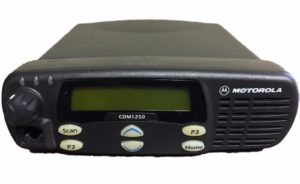
My counter is most of this gear is not capable of VFO, a must when working with other agencies and not familiar with their frequencies. Some models are better than others getting them to transmit in the ham bands if the radio’s band split is just above or below the ham bands. A common practice is to bring a radio with the 450-512 MHz split to transmit in the 440-ham band. Aligning the radio is often needed because it has drifted off frequency. A service monitor or RIB (Radio Interface Box) cable are needed. Everyone should have a service monitor or scope, few do. Many older radios require a PC with a serial port and/or DOS application to be programmed. Serial ports are becoming harder to find on computing devices. I’ve heard USB to Serial Port adapters work, for the most part, with the help of DOSBox. DOSBox is an emulation of DOS that works on modern operating systems. Primarily designed as a tool to run DOS-based games but it also works for other DOS applications. To download a legitimate copy of the Motorola CPS programming software, the subscription cost can get ridiculous. A Radio Reference thread indicated it could range from under $200 to $400 with an increase last year for MotoTRBO equipment. As a former programmer, pirating doesn’t support developers and doesn’t allow the company to put money back into developers and adding features. If you’re kind enough, someone with a subscription maybe willing to program the radio for you or find a ham-friendly radio dealer willing to do the same or sell the software at cost. Pro tip, don’t ask about pirated software in the RR or in other forums.
Out of this debate came a challenge from Bob – K8MD to try out a Motorola radio. I eventually found a project where I need a radio but the programming wouldn’t change often. I did a lot of reading and research on BatLabs and Repeater Builder which are great resources for repurposing commercial radios and building repeaters. The used market is where these radios will be found. Advice from those sites will be very useful in not getting ripped-off, especially decoding the radio model number. My project was to setup an AllStar Link node and it was a perfect time to try a Motorola CDM1250.
AllStar Link, often called AllStar, is an Amateur Radio linking system on a Linux computer, running the open-source PBX telephone switching platform called Asterisk. An AllStar module called app_rpt turns Asterisk into a powerful, full featured, Ham Radio repeater controller, and linking package. It is theoretically capable of controlling hundreds of nodes at a time. Jim Dixon – WB6NIL (SK), developed app_rpt and is considered to be the father of AllStar. Asterisk is typically used as a SMB (small/medium business) phone system.
Like other analog Voice over IP systems (VoIP), such as EchoLink or IRLP, it links radio systems together. AllStar is flexible enough to link other infrastructures together as well. The ability to make connections on any IP network makes AllStar decentralized, meaning it doesn’t need to rely on other infrastructure. No central server for someone to pull the plug resulting in a complete collapse of the network. The concept of a node in AllStar terminology is a loose definition but they all run the same exact software. Node types are generally defined as:
- Repeater: full duplex node and user functions accessed by DTMF
- Simplex node: half-duplex node, also with user functions available by DTMF
- Remote Base node: a half-duplex, frequency agile HF, VHF, or UHF remote base. Will not respond to DTMF on RF.
- Hub node: a common connecting point (similar to Conference or Reflector) with plenty of Internet bandwidth to handle many connections at one time, has no RF connected hardware
Nodes can be public, private, or a combination of both. A public node would be accessible by any other public node on the AllStar network and requires Internet access to the AllStar infrastructure for the phonebook of public nodes. Private nodes can be limited to select users or on a completely private network, like a mesh network, where you don’t want many uses connecting over limited bandwidth links. These are great for connecting repeaters at different sites over a mesh network, point-to-point link, VPN, or public Internet. Private nodes are reserved node numbers ranging from 1000 – 1999.
A hybrid approach of both public and private nodes can be taken. Repeater 1 at location A, repeater 2 at location B, and repeater 3 at location C are all at sites with no or poor Internet. Setup Ubiquity point-to-point links between the repeater site and the Trustee’s house (for example) with a better bandwidth connection. AllStar nodes would be setup at the repeater site and use the Point-to-Point as the route to the Internet.
Say you don’t want public nodes to connect directly to the repeater over long-range WiFi, but wanted to link all three repeaters together and have controllable public access. Nodes at the three repeater sites would be setup the same except as AllStar private nodes. A fourth node would be setup with a public node number at the Trustee’s house. The three repeater nodes and any public nodes could be connected or disconnected from the fourth public node as needed. A friend of mine in Colorado, Jeff – K0JSC, has his WE0FUN “fun machine” repeater sites linked in a similar way. The 15 repeaters are private nodes connected over a private network to a central hub.
Asterisk supports standard protocols for making phone calls over IP, SIP and IAX. Using these standards makes integration easy with other systems that support similar protocols. Options range from softphones, hard phones, other Asterisk systems, to PBX systems on the Internet. A softphone app is an application which runs on a computer or smartphone providing the ability to make calls. Iaxrpt is the Windows PC softphone client and DVSwitch Mobile for smartphones. Hard phones are IP connected phones such as Cisco or Grandstream that support either protocol. A second line on the same Cisco phone used for Ham Shack Hotline is provisioned to dial into my AllStar nodes. An extension can be added to an existing Asterisk phone system allowing any handset to dial into AllStar. Last but not least, a cloud VoIP provider can add forward and reverse autopatch capability to any node! Loose autopatch ability due to new repeater hardware, an expensive addon board, or it became cost prohibitive based on use? Though an active Internet connection is required, a cloud PBX provider, such as voip.ms, adds autopatch functionality for fractions of a penny per minute (including long distance) with pay-as-you-go pricing. For younger hams, autopatches connected an amateur station (often repeaters) with the public land-line telephone system and were popular when cellphones didn’t exist or were expensive.
The first thing about AllStar I found interesting is the ability to interconnect with other ham radio systems. EchoLink support comes out-of-the-box. IRLP can be added but an existing node is needed to copy the system key. To obtain a new node number, the purchase of IRLP hardware is required. Cheapest way is to purchase the preloaded SD card with configured node on the IRLP Node Order Page for the Raspberry Pi.
AllStar has all the essential capabilities of a repeater controller, IDing every 10 minutes and adjustable time-out timer. The time-out timer can be disabled with a command – useful when broadcasting ARNewline, which can be played automatically with a script, or hosting windbag nets. The scheduler is replaced with Unix Cron. I’ve written custom scrips that announce weather conditions, PL tone, and number of connections at certain times during the hour. For a net, my node will check to see if it’s already connected to the far-end node hosting the net. If it is not connected to that node, it will drop all existing connections then connect to the remote node. Dropping all connections seems useful to avoid airing a local net over a large reflector or being booted from an IRLP reflector for being an irresponsible node operator. Some repeater owners like to place repeater objects on APRS maps showing repeater location and frequency. AllStar can inject these objects into the APRS-IS network.
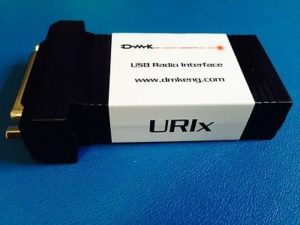
Not unlike the infrastructure flexibility, nearly any sound device recognized by Linux will work with AllStar. Cheap audio fobs (with a few modifications) to commercially or ham produced products are all options. The Repeater Builder site offers many options and products. The connecting device I choose was the DMK URIx. The USB connection converts data over to a DB-25 connector. Pin assignments are listed on the device itself for easy access. I wired up a connector using a Motorola connector kit I purchased off Ebay following instructions I found online from W2YMM. I’ve had a great experience and no problems with the URIx. However, it’s not cheap now running $85 including shipping. In addition, mailing lists are indicating a change in chipset is causing performance issues. I would wait awhile before purchasing this device again.
With Raspberry Pi as an option for running a node, portable nodes are popular for use in a vehicle or backpack. Open Internet ports, or port forwarding, is not a requirement for outbound connections. This is especially useful because cell phone companies make it impossible for open ports due to CGNAT. This was a big problem I talked about with WIRES-X before Yaesu introduced their portable node software. Incoming connections to a portable node on a hotspot will not be possible.
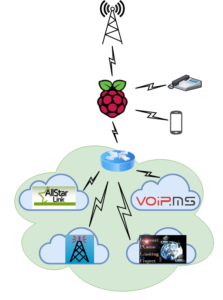
There is a fork of the main project called HamVoIP. They were the first to release a Raspberry Pi image. A Beagle Bone Black image was available but it has been deprecated and no longer updated to concentrate on the Raspberry Pi image. About the time WB6NIL passed, the main AllStar project had some internal conflict, upgrades caused lengthy outages, distributions were becoming dated, and hard to setup. HamVoIP claims to pick-up that slack, improve on the project including infrastructure and code cleanup. Their assertion is having better than 70% of the AllStar market running their image. Recent strides have been made to improve the main AllStar project. I have used both distributions and feel HamVoIP does work better, has more features, frequent updates, and better documentation. Nodes running HamVoIP still utilize the AllStar infrastructure and are fully compatible with non-HamVoIP nodes.
There is a claim that HamVoIP is in violation of GPL license agreements. Again, being a former programmer and someone who publishes articles and presentations, I would be upset if someone was violating my usage terms. However, those making accusations are also making judgement calls based on lack of response – which doesn’t mean there is a violation. In addition, a claim can be filed with the Free Software Foundation or have the copyright owners of Asterisk make a decision. It does not appear either correct course of action is being pursued. Airing this grievance on social media accomplishes nothing, as usual. The HamVoIP side isn’t helping their case by not being transparent and some responses were “feeding the trolls.” A troll is a person online who posts a provocative message to an online forum with the intent of causing disruption and argument. You can read the Reddit thread (some language maybe NSFW) and HamVoIP response. I’m going to keep using HamVoIP until I see a response from someone that has standing in the matter.
AllStar is flexible but definitely a more an administrative (Sysop) system and not entirely user-friendly. Connecting to other AllStar nodes is pretty straight forward. The DTMF sequence is *3 to link and *1 to unlink. Integrations with EchoLink and IRLP can be implemented a couple ways: directly linked to an AllStar node where the AllStar and EchoLink/IRLP node act as one. EchoLink/IRLP can be setup on a different node (often private) on the same AllStar setup. Having separate nodes allows for disabling EchoLink or IRLP connections completely should those nodes cause problems. Great for control, not great for users. An RF user can link and unlink EchoLink/IRLP, not to specific nodes. It maybe possible to do with a script but would add complexity.
Having AllStar and EchoLink/IRLP on the same node allows RF users to link and unlink to those systems. Remembering the DTMF combinations is not easy, I know. Connecting to EchoLink nodes is the DTMF sequence *3 and *13 to disconnect. IRLP is *38 and *18 respectively. Example, EchoLink test node #9999 is *3009999 and *31009999 to disconnect. IRLP test node #9990 is *389990, and *189990. Not exactly straight forward, easy to remember, or the simple “73” IRLP users are used to for disconnecting. Sysops can use the Supermon webpage utility for easier control of a node and can make it read only for users.
I learned some things about using Motorola equipment. My CDM1250 is the high power (40 watt) UHF model. Radios such as the CDM have a 5% duty-cycle. This means transmitting only 3 minutes every hour. Don’t forget, these aren’t rag-chew radios – they’re designed for police and fire which only transmit for short periods of time. Two ways to improve the duty-cycle is to lower the output power and upgrade to active cooling by moving a lot of air over the heatsink. Lowering the power on mine is still 25 watts. These improvements allow the radio to operate normally for a 90-minute net, as long as the fan keeps working. The antenna connector is a Mini UHF female and very easy to break with an adapter and stiff coax. A Mini UHF male to UHF SO-239 female pigtail is a requirement. It relieves the stress on the radio’s connector.
Learning about commercial radios has been a valuable experience. AllStar Link is a very flexible and customizable system that has excellent integration with other infrastructure. I still have a lot to learn and my next goal is to use AllStar for linking all digital modes – yes ones like D-STAR, DMR, and Fusion. Stay tuned!
If you would like to make an AllStar contact, it is best to setup a sked with me via Email.
AllStar node map: http://allstarmap.org/allstarmap.html
Thanks for reading and 73… de Jeff – K8JTK

